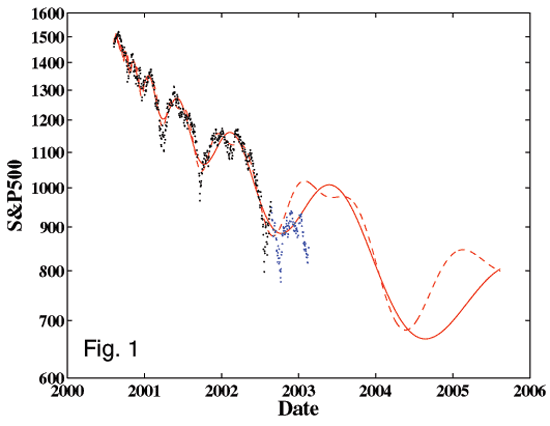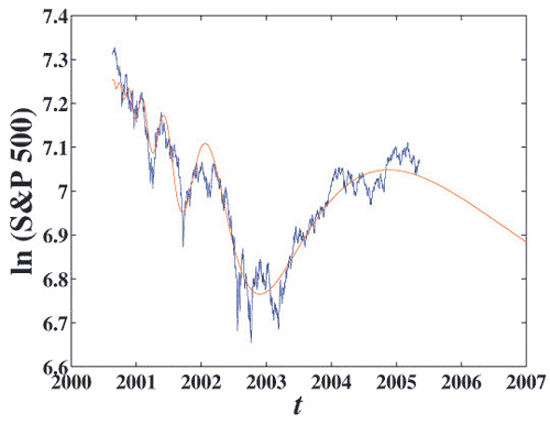Didier Sornette has an interest in financial markets as examples of complex systems. He authored Why Stock Markets Crash : Critical Events in Complex Financial Systems, published in November 2002. He has maintained on his web site for several years a series of predictions regarding the behavior of the S&P 500 index. In initiating this series, he wrote:
“Based on a theory of cooperative herding and imitation working both in bullish as well as in bearish regimes that we have developed in a series of papers, we have detected the existence of a clear signature of herding in the decay of the US S&P 500 index since August 2000 with high statistical significance, in the form of strong log-periodic components.”
His September 2002 paper (with Wei Zhou) entitled “The US 2000-2002 Market Descent: How Much Longer and Deeper?” provides a detailed justification of this assertion, including a comparison of the 1990 Japanese and 2000 U.S. stock market crashes. The evolution of Professor Sornette’s predictions is as follows:
August 24, 2002: Professor Sornette’s initial prediction called for a modest rise in the S&P 500 index during the first half of 2003 to a high of about 1000, followed by a low in mid-2004 below 700 and a modest rebound to about 800 in mid-2005. See the following chart, taken from Professor Sornette’s web site, which shows first order (solid line) and second order (dashed line) log-periodic power law forecasts. The actual S&P 500 index rose to about 1000 in June 2003. However, by mid-2004 it was over 1100 (about 60% higher than predicted). By mid-2005, it reached 1200 (about 50% higher than predicted).

October 2002 – December 2002: Revisions incorporating additional data repeatedly lowered the S&P 500 index prediction for mid-2004 to well below 700 and for mid-2005 to below 800. These revisions reduced the (very poor) accuracy of the original 2004-2005 forecast.
January 2003: A revision incorporating a renormalization and additional data shifted the prediction curve somewhat to the right without significantly affecting minimum and maximum values. The 2004 predicted minimum value (revised to near year end) remained below 700, and the mid-2005 predicted value remained below 800. This revision had little effect on the (very poor) accuracy of the original 2004-2005 forecast.
February 2003 – May 2003: Revisions incorporating additional data further lowered the prediction curve. The 2004 predicted minimum value fell just below 600, and the mid-2005 predicted value fell to about 620. These revisions reduced the (very poor) accuracy of the original 2004-2005 forecast.
June 2003 – November 2003: Revisions incorporating additional data started to elevate the far-future part of the prediction curve. The 2004 predicted minimum value moved above 600, and the mid-2005 predicted value rose to about 650. This revision marginally improved the (very poor) accuracy of the original 2004-2005 forecast.
December 2003 – January 2004: Professor Sornette announced that the U.S. stock market antibubble may have ended, that “the market might have started to cross-over from the first-order to the second-order formula.” In which case the predictions provided would be wrong.
February 2004: Professor Sornette, using a method outlined in his October 2003 paper (with Wei Zhou) entitled “Testing the Stability of the 2000-2003 US Stock Market ‘Antibubble'” confirmed that the U.S. stock market antibubble had ended and discontinued updating the original prediction. After examining the behavior of the S&P 500 index denominated in foreign currencies, he tentatively concluded that “the strong impact of the Fed intervention has perturbed the fingerprints of the antibubble, so that we conclude that it has ended in the US, while maybe in reality the herding bearish-bullish oscillations are still present but are hidden by the distorting feedback actions of the Fed.”
March 2004: In reviewing the behavior of the actual S&P 500 index from May 2003 to March 2004, Professor Sornette identified an “unsustainable super-exponential growth” entering a critical zone that “could be a crash looming or more probably an overall downward trajectory…, if the dollar stabilizes.”
April 2004 – May 2004: Professor Sornette continued updating S&P 500 forecasts denominated in foreign currencies and gold. He added antibubble analyses of foreign stock markets.
June 2004: Professor Sornette continued updating S&P 500 forecasts denominated in foreign currencies and gold and antibubble analyses of foreign stock markets. He added analyses of the Russell 3000 denominated in foreign currencies and gold.
July 2004 – November 2004: Professor Sornette continued updating S&P 500 forecasts denominated in foreign currencies and gold, antibubble analyses of foreign stock markets and analyses of the Russell 3000 denominated in foreign currencies gold. He added and updated an analysis of the Russell 3000 denominated in dollars, forecasting a substantial decline of 20%-40% through 2005. The actual Russell 3000 index has advanced about 4% so far in 2005.
December 2004: Professor Sornette suspended all forecasts and acknowledged that his predictions for the U.S. stock market “have not been verified.” He explained that: “The origin of our failure to forecast the rebound of the market in 2003 can be traced back, in our opinion, to the following simple point: the mechanism underlying our projection is UNIQUELY based on the imitation and herding behavior of investors. It neglects the fundamental input of the economy as well as the external manipulations by the Fed and other institutions, the impact of foreign policy and foreign investors, the dollar effect (all these being possibly inter-related). It takes the extreme view that all these actions are endogenously determined and driven by the collective action of the investors. This is too simplistic because, in general, one can understand the evolution of [a] system as the result of an entangled combination of endogenous organization but also as a response to external news and exogenous shocks… Our live [experiment] from Oct. 2002 until Nov. 2004 has clearly demonstrated the limits of this approximation. The good news is that there are ways to incorporate the [Fed’s] action and the dollar effect in an extended version of our theory which is now under development to combine our herding theory with all these other factors.”
May 2005: After testing a range of alternative models, Professor Sornette introduced a new S&P 500 index forecast based on an extension of the second-order Landau LPPL [log-periodic power law, the ‘signature of herding’] formula…,” finding it superior “to all other possible models including economic factors.” [We infer that this new approach is not much different from the original second order antibubble solution of October 2002 shown above.] See the following graph for the new forecast on a natural log scale, taken from Professor Sornette’s web site. This graph indicates that the S&P 500 index will fall to about 1080 by the end of 2005 and 980 by the end of 2006. Since May 2005, the actual S&P 500 index has moved slightly higher to about 1230.

June 2004 – July 2004: Revisions incorporating additional data did not much affected the May 2005 forecast.
August 2004: A revision incorporating additional data did not much affected the May 2005 forecast. Professor Sornette added a third-order Landau LPPL forecast for the S&P 500 index, which is roughly flat through 2007, “because we believe it is possible that the market is undergoing a transition from the second-order regime.” He also plotted “20 equiprobable scenarios” that encompass a moderately rising, flat or declining market through 2007. He estimates the likelihood of moderate growth at 15%.
In summary, Professor Sornette’s attempt to model one equity market via diligent analysis of similarities to another equity market during a different time does not work, perhaps because the model is simplistically behavioral or because randomness dominates predictability.